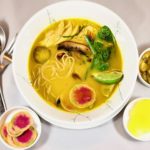
A few decades ago, most Chinatowns in America broadened to include a smattering of Vietnamese restaurants. There wasn’t much buzz about that food at first. Today, not only are there lots of Vietnamese restaurants in Chinatowns, with lots of buzz, but they are about to have on their hands a break-out dish; I know this, because in New York, in San Francisco, in Honolulu I have heard people say “let’s go down to Chinatown and get some phở.” No dish is more deserving of a break-out, I’m telling you. Phở is a big bowl of beef stock, and beef, and rice noodles, and fabulous Southeast Asian seasonings—into which, at the table, you add more Southeast Asian seasonings, and a profusion of fresh herbs. On a cold day, it is heaven on earth—but I’d love it on any day, no matter what the thermometer says. It is a specialty of Hanoi, but there are many regional variations. Think of it as a Southeast Asian pot au feu—which is quite curious, since the pronunciation of the dish (FUH) is damned close to the French pronunciation of “feu,” and we know that French colonials were around for quite some time. Linguists with whom I’ve spoken, by the way, deny the connection. I say “feh,” and just grab another bowl.
makes 4 main-course servings
4 pounds meaty beef bones
5 quarts water
1 large onion, unpeeled
6 whole cloves
a 2″ piece of fresh ginger root
4 large shallots, unpeeled
3 whole star anise
a 3″ cinnamon stick (preferably Vietnamese)
8 ounces Vietnamese rice noodles (bánh pho)
8 ounces sirloin or filet, very thinly sliced
1 cup mung bean sprouts
1 loosely packed cup cilantro leaves
1/2 cup sliced scallions (each slice 1/4″ thick)
2 tablespoons Vietnamese fish sauce (nuoc mam), or to taste
accompaniments:
2 loosely packed cups of cilantro leaves
1 loosely packed cup of mint leaves
1 loosely packed cup of Thai basil leaves (or other basil leaves)
1 cup mung bean sprouts
1 cup sliced scallions (each slice 1/4″ thick)
2 small red hot chilis (such as Thai bird peppers), thinly sliced
Vietnamese fish sauce (nouc mam)
hot sauce (like Sriracha sauce from Thailand)
2 limes, each cut into 4 wedges
1. Place the bones in an 8-quart stock pot, cover the bones with the water, and bring to a boil over medium heat. As soon as the broth comes to a bowl, lower the heat, bring to a simmer, and cover.
2. Meanwhile, peel the loose outer skin from the onion, but leave some skin on. Cut in half and stud each half with 3 cloves. Cut the ginger in half, and cut the shallots in half. Place a heavy cast iron skillet over high heat, and moderately char the onion, ginger and shallots. Add to the pot. Add the star anise and the cinnamon stick. Simmer the broth for 4 hours, occasionally skimming any impurities from the surface.
3. Strain the broth, clean out the pot, and return the broth to the cleaned pot. Let the meat bones cool slightly, then take off the meat, shred and set aside. Discard the bones.
4. Cook the broth, uncovered, over medium-high heat. Reduce until you have about 8 cups of liquid.
5. While broth is reducing cook the rice noodles in a separate pan of boiling water, taking care not to overcook them. Drain.
6. Divide the noodles among 4 large, deep soup bowls. Divide the thinly sliced meat and the reserved shredded meat into 4, and add to the bowls. Divide a cup of bean sprouts, a cup of cilantro and 1/2 cup scallions into 4, and arrange on top of the meats.
7. Bring the broth to a boil, and add fish sauce to taste. Season with salt, if necessary. Pour a 1/4 of the broth into each bowl. Serve at once with accompaniments.


